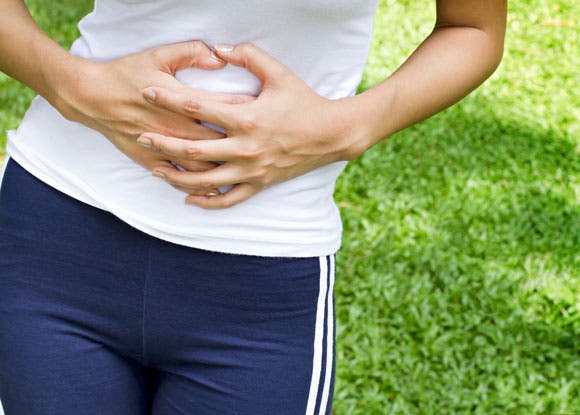Prevent & Cure Mid-Run Pain!

Photo by Shutterstock.com

Sometimes running really #*%@ing hurts! What to do when the suffering starts…
Painful calf cramps, the dreaded wall of fatigue, stomach-churning nausea— they sure can make for some miserable miles. Lauren Lusthaus, 42, of New York City, knows these feelings firsthand. The six-time marathoner says that her first 26.2-miler was wracked with stomach pain. “I was excited and anxious. Then you add gel into the mix, and by mile 10 all I could think about was whether I’d need to take a bathroom break,” recalls Lusthaus, who was fortunately able to push through the pain and finish her race.
Sure, these unsavory sensations aren’t as serious as sprained ankles or stress fractures, but they can throw a wrench into your workout or race. Here’s how to prevent pain if possible, and to handle every kind of ouch when it rears up mid-run. . .
Calf Cramps
CAUSE
Your race is going well, but all of a sudden you can barely walk—let alone run—because of excruciating calf pain. A. Lynn Millar, Ph.D, professor of physical therapy at Winston-Salem State University, explains, “Running harder than you have been in training puts more strain on muscles and makes them more likely to cramp. The other potential reason is dehydration.”
CURE
Prevent symptoms by hydrating well and including high-intensity workouts in your training. If you feel cramps coming on, slow your pace, breathe deeply and try to hang in there until it passes. Millar recommends taking in an electrolyte drink as well. If the pain persists, stop and stretch by placing your toe on a curb and pressing your heel down.
Nausea and Belly Pain
CAUSE
Even seasoned runners like Lusthaus experience stomach pain, nausea, diarrhea and vomiting. Stop symptoms before they start by eating your pre-race snack no less than a full hour beforehand. “When you exercise, your body redistributes the blood flow to the muscles and decreases the amount going to the stomach,” says Millar, adding that nervousness may also increase stomach acid production.
CURE
Test-drive your meals and mid-run fuel during training so you’ll know what aggravates your stomach. “Some people are more likely to get intestinal problems if they’ve had milk products,” says Millar. Menstrual cycles may also exacerbate cramps. If this is true for you, avoid racing during your period— or ask your doctor about modifying your birth control schedule so it won’t affect competition. Lusthaus now manages her symptoms by taking Imodium the night before a big race. “It makes all the difference,” she says.
Extreme Fatigue
CAUSE
Have you ever hit that proverbial wall mid-race, where each step you take feels like a serious effort? The culprit is easy to pinpoint. “Sudden fatigue is usually related to a drop in blood glucose levels or dehydration,” says Millar.
CURE
Avoid an energy landslide like this by eating and hydrating properly before and during your race. For workouts and races lasting one hour or longer, fuel with electrolyte drinks and chews or gels. Since heat contributes to dehydration, be extra careful on steamy summer days by slowing your pace and drinking extra fluids. As always, listen to your body and scale back or stop if you are feeling unwell. “Dehydration and heat stroke can be life-threatening conditions,” cautions Millar.
In Defense of Ouch
Sometimes agony leads to ecstasy.
Running can be incredibly uncomfortable, but that’s not always a sign that something’s wrong, says Millar. Symptoms like achy, tired legs or labored breathing during workouts are often signs that faster race times are in your future. “In order to improve, we have to have our muscles work at a greater intensity. Our heart and respiration have to go up to provide oxygen to our muscles. This is part of training,” she explains. There’s nothing wrong with chatting on the phone while leisurely jogging on the treadmill—but if you do this every workout, don’t expect a personal best at your next race.